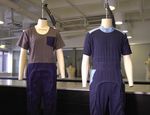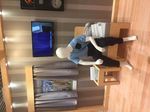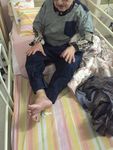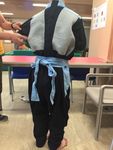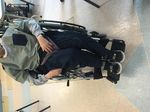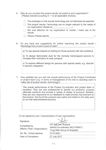RAE 2020 Development of new anti-strip jumpsuit for the residents with mental disorders
←
→
Page content transcription
If your browser does not render page correctly, please read the page content below
RAE 2020 Development of new anti-strip jumpsuit for the residents with mental disorders Dr. C.P. Ho PolyU UoA 38
Contents
Chapter Topic Page
1 Descriptor 3
2 Researcher’s background 4
3 Research context 5
4 What constitutes the research output 6
5 Research questions 7
6 Research material 8
7 Research methodology 12
8 Dissemination and distribution of outcomes 15
9 References 26
10/2019 Development of new anti-strip jumpsuit for the residents with mental disorders
2C.P. Ho
Development of new anti-strip jumpsuit for the residents with
mental disorders
Descriptor
One function of anti-strip jumpsuit is to prevent the wearer from disrobing. However, nurses at some care centres
reported that current anti-strip jumpsuits do not address this problem because:
- The residents can take off their diapers and soil themselves
- The fabric of current jumpsuits is not comfortable for residents
- The fabric and accessories are not durable under a rigorous laundering and drying
procedures
In this project, new functional anti-strip garments were designed for residents staying at care centres of the Tung
Wah Hospital Group, a collaborative charity group in Hong Kong. Many residents in these centres have mental and/or
physical disorders. The new design not only solved the main problems of the current anti-strip jumpsuit but also
enabled residents to dress smarter.
The research team analysed data from a focus group interview with carers, nurses, and family members of residents.
Wearer trials involving 30 participants were conducted to test the design. A list of fabric tests were also designed to
ensure that the quality of fabric and accessories were suitable for this specific type of garment. Finally, 500 sets of
new jumpsuits (8 styles) were produced for approximately 200 residents living in more than 30 care centres in Hong
Kong in an effort to improve their comfort and hygiene. Additionally, a new image was successfully created for the
residents to improve their overall appearance. The product specifications, testing requirements, and the details of
fabric properties were listed in the technical manual for future re-ordering of the garments.
The impact of the research was not limited to academia or collaborators, but has also benefited the entire
community. The project leader was invited to write a book chapter to share the knowledge he gained throughout the
project to inform other carers who care for persons suffering from dementia residing at home. (299 words)
10/2019 Development of new anti-strip jumpsuit for the residents with mental disorders
3C.P.Ho Researcher’s background Dr. Ho’s research focus is on the investigation of functional clothing. He had experience to design functional uniform for Hong Kong sport team and adaptive clothing for health care centres. Apart from the practice-based research, he also investigates the relationship between design and comfort level of clothing with the support of scientific data. The examples included the development of design details to enhance garment’s thermal comfort; and the evaluation of garment construction to fit Chinese men with apple body shapes. 10/2019 Development of new anti-strip jumpsuit for the residents with mental disorders
C.P. Ho
Research Context
Nurses and carers at some care centres reported that the
current anti-strip jumpsuit found from the market could not
solve the problem effectively. In some cases, residents in care
centres could take off their diapers and soil themselves. This
behaviour led to personal hygiene problems and pressure on
the staff. However, limited research had been studied to
suggest effective design to improve the anti-strip garments.
Through observation and interview with carers, nurses and
residents’ family, we identified that the needs varied between
the residents and thus devised different designs to meet
their various needs. As a result, 8 anti-strip garments were
created for the Dementia residents from adult to seniors,
with or without physical disorders.
This project was 100% funded (HK$ 1.3M) by the Hong Kong
Government (Innovation and Technology Funding).
10/2019 Development of new anti-strip jumpsuit for the residents with mental disorders
5C. P. Ho
What constitutes the research output / body of work
1. New anti-strip jumpsuits
500 sets of new jumpsuit were adopted in care
centre to reduce the hygienic problem of
residents which was caused by disrobing (2015
– 2017)
2. Technical report and specifications
The product specification include design,
analysis of questionnaire, material use and the
full data of testing results were provided for
future product development and re-ordering
(2017)
3. Knowledge sharing
- Exhibition in the community to promote the
design and sense of caring to residents (Jan, 2018).
- Invited talk to share the knowledge to other carers
at hospital and care centres (Feb 2018) .
- A book chapter has been published to suggest
useful tips to carers to customize household
garments to prevent the wearer from disrobing
(2017).
- Newspaper report (30 Oct 2016)
- Youtube videos and report on government
website to promote the new image and technical
advancement of the new design (Oct 2016 & Feb
2017).
10/2019 Development of new anti-strip jumpsuit for the residents with mental disorders
6C. P. Ho
Research questions
The research sets out to
1. Develop series of new anti-strip jumpsuits to the residents with mental disorders;
2. Evaluate the quality of the new anti-strip jumpsuit (included design, fabric and accessories)
through lab test and wearer trials;
3. To promote the new design to the community to raise the sense of caring of Dementia patients.
10/2019 Development of new anti-strip jumpsuit for the residents with mental disorders
7C. P. Ho
Research material
Behavioural expression consists of two main
categories: distress, such as hitting, vocalisation, etc.,
and disinhibition of disrobing (Capezuti et al., 2014).
The tendency to remove one’s clothes is a common
symptom for seniors with dementia and Alzheimer’s
disease (Maville & Huerta, 2013). At this stage, it is
difficult to explain this phenomenon. There are some
assumed reasons for seniors’ inappropriate disrobing,
such as discomfort, hallucinations and sexual reasons
(Giving Care Team, 2017). With the risk of
incontinence, many patients wear diapers. However,
this causes discomfort to their skin. Sometimes they
strip because they are too hot or because they cannot
think logically. While hallucinations often happen at a
later stage of dementia, patients may believe that they
must undress due to the hallucination of bedtime or
crawling bugs on their clothes, for example. In some
cases, Alzheimer’s patients may disrobe to fondle
themselves unconsciously without realising that it is
inappropriate to do so in public. There is no clear way
to understand the behaviour of the patients, so
inappropriate undressing is often a problem in
hospitals and care centres.
Residents in anti-strip jumpsuit
sourced from the market
10/2019 Development of new anti-strip jumpsuit for the residents with mental disorders
8C. P. Ho
Research material
The research under discussion in this paper arose from the
identification of a behavioral tendency common among
patients suffering from conditions such as dementia. It
involved the development of a garment, hereafter referred
to as an 'anti-strip' jumpsuit, designed to deter such
patients from removing their outerwear. The main
purpose of this garment type is to prevent the patients/
residents from tearing or taking the garment off. In the
development of such garments, there should be more
emphasis on functionality, fabric quality and cost control.
Design sketch of safeguard detail at the bottom hem One of the final prototypes for senior residents
10/2019 Development of new anti-strip jumpsuit for the residents with mental disorders
9C. P. Ho
Research material
Examples of the technical
specification: Product specification,
design details and size specification
10/2019 Development of new anti-strip jumpsuit for the residents with mental disorders
10C. P. Ho Research material Anti-strip jumpsuits were reordered by more care centres 10/2019 Development of new anti-strip jumpsuit for the residents with mental disorders 11
C. P. Ho
Research methodology
Problem Definition and Research
Before starting a new set of anti-strip
garment designs, the research team
organised field trips to five targeted care
centres to observe
1) the dressing process of residents with
the help of carers,
2) the appearance of current jumpsuits
and
3) the laundry facilities used in care
centres.
During each visit, in-depth interviews with
carers and nurses were conducted to analyse
aspects of current jumpsuits that were
satisfactory and those that were not.
In general, current jumpsuits did not
perform well, with carers and nurses worried
about some specific aspects of these
jumpsuits. At this stage, the problems of the
current anti-strip garments were Interview with carers and nurses
summarised based on feedback from
frontline personnel and the research team’s
observations.
10/2019 Development of new anti-strip jumpsuit for the residents with mental disorders
12C. P. Ho
Research methodology
Creative Exploration
The design of this anti-strip jumpsuit
remained a jumpsuit, adopting the same
zipper placement as the currently available
jumpsuits on the market. Based on the data
obtained from the centres and the
observations of the research team, two
versions were created to meet the specific
needs of the residents.
In the new design, a mesh panel was placed
under the back panel. The thin, spongy mesh
not only enhanced the breathability in the
back area but also facilitated heat and water
vapour transmission. It was also durable and
more resistant to laundry than a thin single
layer of sports net mesh. A design with hard
objects, like buckles or zippers, should be
covered with fabric, as it might injure the
wearer or cause skin allergies (Weckmann,
2011; Caldas, Carvalho, Lopes & Souza, 2019).
Design presentation to care centres
10/2019 Development of new anti-strip jumpsuit for the residents with mental disorders
13C. P. Ho
Research methodology
Wearer trials
In this research, two rounds of wearer trials
were conducted with the focus group before
the final prototype was manufactured. Each
wearer trial lasted four weeks. As the
residents were unable to respond to the
research team with questions, the letters of
consent were signed by their family
members. After the end of each wearer trial,
in-depth interviews with carers, nurses and
the families of the subjects were conducted
to obtain feedback and suggestions before
producing the final prototype and giving it to
each collaborating care centre. During the
wearer trial, the carers and nurses recorded
the pros and cons of the new design, and also
the reaction and behaviour changes of the
residents that they could observe in the
wearer trials.
Totally more than 30 participants were
involved in wearer trial and their age range
was 40 – 85.
Figures showing the wearer trials on different designs
10/2019 Development of new anti-strip jumpsuit for the residents with mental disorders
14C. P. Ho
Dissemination and distribution of outcomes
Year Details
Artefact
2015- 2017 Adoption of 500 sets of jumpsuits for more than 30 care centres in Hong Kong
Exhibition
2018 Exhibition in the community (Hong Kong). January 2018
Online documentary/video
2017 Anti-strip Jumper - Innovative and intimate apparel design for the people who need special care, Newsletter
published by Innovation and Technology Commission (HKSAR)
2016 Anti-stripe Jumper: Integration of Design and Function. Youtube clip, published from Hong Kong Research Institute
of Textile and Apparel. 18/10/2016
Knowledge sharing
2018 Invited talk to care centres and hospitals (by TWGHs). Feb 2018
Book chapter
2017 Invited chapter writing for Alzheimer’s Community Support Centre, Full Life Day Care Centre for the Elderly, TWGHs
Newspaper report
2016 New technology boosts safety and hygiene in Hong Kong’s care homes, South China Morning Post. 30/10/2016
Evaluation report
2017 Evaluation report and appreciation from the TWGHs
10/2019 Development of new anti-strip jumpsuit for the residents with mental disorders
15C. P. Ho
Dissemination and distribution of outcomes
Exhibition in the community (January 2018, TKO, Hong Kong)
10/2019 Development of new anti-strip jumpsuit for the residents with mental disorders
16C. P. Ho
Dissemination and distribution of outcomes
Invited knowledge sharing to care centres and hospitals (10 Feb 2018)
10/2019 Development of new anti-strip jumpsuit for the residents with mental disorders
17C. P. Ho
Dissemination and distribution of outcomes
Newsletter published by Innovation and Technology Commission (HKSAR) Feb 2017
Anti-strip Jumper - Innovative and intimate apparel design for the people who need special care
Link: https://www.itc.gov.hk/enewsletter/170201/en/anti_strip_jumper_innovative_and_intimate_apparel_design.html
10/2019 Development of new anti-strip jumpsuit for the residents with mental disorders
18C. P. Ho Dissemination and distribution of outcomes Newsletter published by Innovation and Technology Commission (HKSAR) Feb 2017 Anti-strip Jumper - Innovative and intimate apparel design for the people who need special care (Captured from the website) Innovative apparel designs, combined with unique capabilities and intimate care and concern, can benefit all sectors of society, including people with emotional or behavioural disorders who need special care. The "Anti-strip Jumper", recently developed by The Hong Kong Research Institute of Textiles and Apparel (HKRITA), is a good example. The new jumpsuit's thoughtful design is more comfortable than the previous attire and deters the wearers from removing their diapers at inappropriate times, thus improving their quality of life through better hygiene. At the same time, it gives caregivers in care centres more time to take care of their other needs. The improved design of the "Anti-strip Jumper" developed by the research team includes mixing and matching different materials for a trendy style, thus getting rid of the labelling effect of traditional jumpsuits which look more like a medical uniform in terms of design and colour. Intensive testing for breathability, water resistance and breaking load was undertaken with a variety of fabrics, to withstand the rigorous demands of the laundry process in care centres whilst also addressing the issue of the sensitive skin of elderly patients. These tests ensured that the fabric used in the new jumpsuits would meet international standards for function and durability, and also be comfortable for the wearers. Functional darts were incorporated into the jumpsuit design to better fit the 3D contours of the body, allowing a greater range of unrestricted movement for the wearer. A double layer of velcro and a stand collar design were found to act as an effective barrier to prevent the wearer from spontaneously removing their diapers. In order to provide easier dressing for patients with impaired mobility, a Velcro opening was added on one side of the shoulder position of the jumpsuit. In addition, a mesh panel was placed in the upper back area of the jumpsuit so as to increase the breathability of the whole garment. Four centres under the Tung Wah Group of Hospitals were invited to take part in the project trial. The care homes participated in three wearer trials, each lasting two weeks, during the project period. After each trial, researchers collected opinions from caregivers to improve the design, comfort and functionality of the jumpsuits. The research results will also provide a comprehensive reference for similar organisations. Established in April 2006 under the funding of the Innovation and Technology Commission of the HKSAR Government, HKRITA aims to provide a one-stop service for applied research, technology transfer and commercialisation, and to help facilitate the textile and clothing industries to enhance their high value-added manufacturing and servicing activities, helping to sharpen Hong Kong’s competitive edge in the global textile market. 10/2019 Development of new anti-strip jumpsuit for the residents with mental disorders 19
C. P. Ho
Dissemination and distribution of outcomes
Newspaper report: South China Morning Post. 30/10/2016
Title: New technology boosts safety and hygiene in Hong Kong’s care homes
Dr Ho Chu-po with a pair of anti-strip overalls, which he designed. Photo: David Wong
Copyright ©2019 SCMP. All rights reserved. Reprinted with permission.
Link: https://www.scmp.com/news/hong-kong/education-
community/article/2041362/new-technology-boosts-safety-
and-hygiene-hong
10/2019 Development of new anti-strip jumpsuit for the residents with mental disorders
20C. P. Ho
Dissemination and distribution of outcomes
Youtube clip, published from Hong Kong Research Institute of Textile and Apparel. 18/10/2016
Topic: Anti-stripe Jumper: Integration of Design and Function
Video link: https://www.youtube.com/watch?v=typEeK_RY2w
10/2019 Development of new anti-strip jumpsuit for the residents with mental disorders
21C. P. Ho
Dissemination and distribution of outcomes
Book chapter (written in Chinese) (Publisher: Tung Wah Group of Hospitals)
In Hong Kong, many people suffer from varying degrees of
cognitive impairment. The disease directly affects the ability to
receive external signals, sometimes producing unusual
responses. Patients, many of whom are older, are not aware of
their strange reactions. In addition to cognitive problems, as they
age, the physical condition of their bodies declines. Some of the
elderly have damage to parts of their bodies, so they cannot do
things that are normally simple. When so many effects are
combined, such people cannot take care of daily actions
themselves, such as dressing and eating. These patients thus
require care from others. However, as described above, this
places stress on those who take care of them
(often the family members of the patient or the external medical
staff).
The author has worked with day care centres at the Tung Wah
Group of Hospitals to study and design uniforms to serve patients
with cognitive impairment. From the study, we started with the
use of cloth: to improve the size and fit of the jumpsuit, the
research team designed various functional clothes for elderly
patients. Some of the patients needed to remain in bed for long
hours; others spent the majority of their time in a wheelchair.
Some had behavioural disorders such as taking their own diapers;
others were physically handicapped. Based on past experience
and our observations of their daily lives, we can develop clothes
that enable caregivers to more easily or more efficiently solve
some of these daily life problems. Here, we will classify the
patient’s situation and then introduce some of the ideas.
10/2019 Development of new anti-strip jumpsuit for the residents with mental disorders 22C. P. Ho
Dissemination and distribution of outcomes
Book chapter (con't)
1. Taking off own diaper
Due to incontinence, some patients need to wear a diaper, but because of a loss of awareness or other reasons, some
patients may to take off or tear off their own diapers. Doing so makes them dirty. The anti-strip jumper can help resolve
this problem. A one-piece jumper design is normally adopted to achieve this function (Figure 1): the caregiver can change
the diaper for the patient by easily unzipping the jumpsuit. However, some designs cannot prevent the patient from
taking off his or her diaper because the patient can also unzip the jumper easily. To solve this problem, we suggest that
the caregiver can sew stronger Velcro at the end of the zipper or the hem level of the jumper: a patient cannot take off
the Velcro easily. To reinforce this design, caregivers can attach another layer of Velcro for ‘double protection’ (Figure 2).
As the two layers of Velcro attach to each other, the elderly may not able to tear them off to find the zipper end in a short
time because their hands are relatively weak and they are inflexible. In some cases, a small buckle can be added to the
zipper end and attached to the pants. Even if the patient can remove the two layers of the Velcro barrier, his or her
hands may not flexible enough to open such a small buckle to unfasten the zipper.
In addition, some patients take off the diaper by putting their hands through the large openings of cuffs and necks. In the
design of clothes, we can consider the size and shapes of the collar and cuffs and make sure that they are not too big.
Furthermore, designing a small stand collar on the clothes can make the design look better and prevent the patient from
inserting his or her hands.
2. Daily changing of clothes
Many caregivers found that some patients cannot lift their arms to dress or take off their clothes. This may be because
the patient cannot successfully understand or follow instructions for ‘arms up’. In other cases, it may be that the patient
feels pain when moving his or her arms at such an angle. One of the easiest ways to solve this problem is to avoid using
garments with front openings. For some pullover garments, the caregiver can cut the clothes on the sides and add
buttons or zippers to attach the front and back together (Figure 3). Thus, even if the patient’s arms are down, caregivers
can easily help them change their clothes. This technique can also be used for pants. If the patient has difficulty lifting his
or her legs, we can cut the pants through the two sideseams and then attach buttons or zippers on both sides of the
pants. This will greatly reduce the inconvenience of the caregiver when changing patients’ clothes.
10/2019 Development of new anti-strip jumpsuit for the residents with mental disorders 23C. P. Ho
Dissemination and distribution of outcomes
Book chapter (con't)
3. Material
Some patients may have skin problems. When they feel itchy, their temper worsens. This poor temper may
affect the relationship between patients and caregivers. Therefore, in the choice of fabric, we should start with
breathability. For patients who are often in bed or sitting in a wheelchair, use of mesh fabric in the right
places, such as the back and underarms, is recommended. In addition, the choice of fabric should work with
the temperature and humidity of the home centre to ensure sure the patient does not become hot easily. A
patient experiencing heat may suffer from itchiness. Experience has shown that the right choice of a
breathable fabric can remedy skin problems and improve patients’ moods, making them calmer and more
stable.
4. Colour
In the use of colour, caregivers can observe the preferences of the patient and pick the right colours and
patterns for them. Caregivers should avoid using some bright colours because they may overstimulate the
patient. Soft, natural colour tones are recommended.
Conclusion
Patients behave in their own ways in daily life, and one or two designs may not meet all daily needs. We may
not easily find perfect designs for the market. Caregivers can thus make small modifications to existing
clothes. With serious cases such as patients with particular behaviours, caregivers may need to obtain
professional assistance to design suitable clothing.
10/2019 Development of new anti-strip jumpsuit for the residents with mental disorders 24C. P. Ho Dissemination and distribution of outcomes Evaluation report and appreciation from care centres 10/2019 Development of new anti-strip jumpsuit for the residents with mental disorders 25
C. P. Ho References Calda, A., Carvalho, M., Lopes, H., & Souza. (2018). Ergonomic clothing design for care-dependent elderly women. In G. Montagna & C. Carvalho (Eds), Textiles, Identity and Innovation: Design the Future (pp. 113 – 118). London: CRC Press Capezuti, E. A., Malone, M. L., Katz, P. R., & Mezey, M. D. (2014).The Encyclopaedia of Elder Care. The Comprehensive Resource on Geriatric Health and Social Care. New York: Springer Publishing Company. Giving Care Team (2017).Coping with Disrobing in a Senior Loved One with Alzheimer’s and Other Dementia . Retrieved from https://www.silverts.com/giving-care/index.php/ coping-with-disrobing-in-a-senior-loved-one-with-alzheimers-and-other-dementia/ Maville, J. A., & Huerta, C. G. (2013).Health Promotion in Nursing. Clifton Park, NY: Delmar, Cengage Learning. Weckmann, R. (2011). Allergies caused by textiles. In V.T. Bartels (Ed.), Handbook of Medical Textiles . Cambridge: Woodhead Publishing Ltd. 267–279. 10/2019 Development of new anti-strip jumpsuit for the residents with mental disorders 26
C. P. Ho Declaration Unless the sources are specified in this Body of Work, the copyright of the materials presented (excerpts, photos, videos, figures, drawings, diagrams and media) is owned by the author. 10/2019 Development of new anti-strip jumpsuit for the residents with mental disorders 27
You can also read


